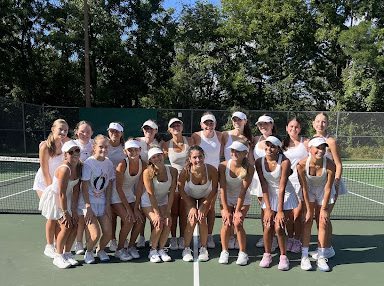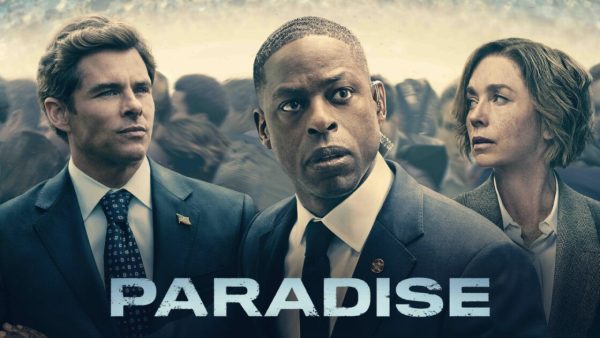Students, staff embrace the idea of choice media in the classroom
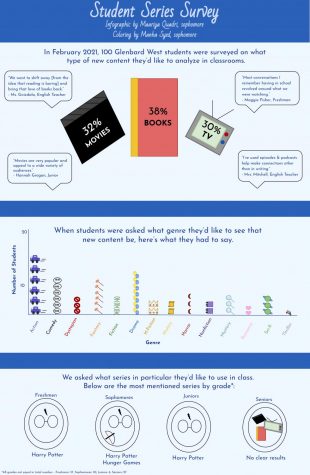
Picture this: It’s the first day of class, and you’re given the syllabus, and along with Romeo & Juliet, Beowulf, and Catcher in the Rye, you see opportunities where you can choose your favorite book, movie, or TV show to analyze. Sounds almost too good to be true, right? Having students add more of their choices to classrooms seems like a great idea to most students, and some teachers agree, at least to an extent. Let’s see what 100 students at Glenbard West, along with a few of their teachers, had to say on the subject.
Sophomore Elizabeth Tanner states that introducing more material chosen by students may also introduce “concepts that not a lot of people think about.” Senior Mary Dillon agrees that this is useful, contemplating that new concepts will also spark more conversations between students, saying, “[Students] need to talk to each other more and recommend what to watch and read.”
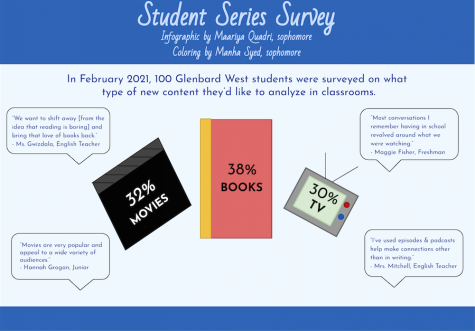
One hundred Glenbard West students were surveyed on what book, TV, or movie series they’d like to see incorporated into their classes. When asked what kind of media in particular they’d like to use in class, many students said books. Sophomore Skylar Oh approves, saying, “There are some TV shows that aren’t that relatable or applicable in your daily life.”
Books were closely followed by movies and TV, for good reason. Freshman Maggie Fisher says that this is no surprise, as “we’ll read books for school, but most conversations [with other students] I have revolve around what we are watching.” Senior Joseph Blestas adds to this, saying that “everyone’s hooked on technology and screens as of late.”
When asked why students chose the particular media and content they did, answers ranged from childish nostalgia to just plain popularity.
According to the Association for Supervision and Curriculum Development, “Students learn more when they are motivated,” supporting the idea that if offered more choice in what students study in class, students will do better academically since they are enjoying what they’re learning.
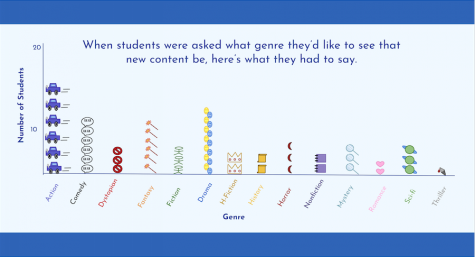
In terms of genres, while there were a host to choose from, action, drama, and fantasy were the top three. Senior Mary Dillion was unfazed by these results, commenting “ High schoolers are [the creators of] drama.” Sophomore Skylar Oh explains, “Action’s got a lot happening so you won’t be bored reading or watching it as you would in other genres.”
Hannah Grogan, a junior, hypothesizes that the reason for fantasy’s popularity is because it “provides some escapism from all the stress of high school.”
Students loved the prospect of including their favorite series into classrooms, from famous books that became movies such as Harry Potter to shows such as Breaking Bad. Mrs. Gwizdala, an English 3 and AP Language teacher, explains that before adding new works into the curriculum, they “have to be approved by the school board, which is a pretty lengthy process. There is a lot of work, energy, and time on the teacher’s part as well to create a whole new curriculum.” She acknowledges “that we have issues in regards to representation [in curriculum]. When you look at the text, it’s very white and it’s very male. We [teachers] see that and we have this sheer desire to ensure that there’s better representation.” And while the board approves new texts, Mrs. Gwizdala is meanwhile “giving time and space for independent reading to expose students to different perspectives and ideas” in her own classroom.
English Department Chair, Mr. Peterselli, hopes that introducing more independent reading will “compel students to read, and read all the way through a book.”
Renown English teacher and author on adolescent literacy, Kelly Gallagher, says these efforts of giving “students a choice” are done in hopes of helping them “read and write more.”

Mrs. Mitchell teaches Independent Literature and cautions that in regards to adding more modern media, “You never want to use media for media’s sake. You have to pick and choose and think about what’s going to help get across to the students.” To do this, she often uses podcasts, TV clips, and even TikToks. Mrs. Mitchell states, “There is a high interest [among students] because it’s a different way to present material, and they are on current events that they can make connections based on what they’re reading or what they’re familiar with.” The ASCD builds on this, saying that getting on a student’s level will “empower them and help development, and take more responsibility of their own learning.”
The Glenbard West staff are working extremely hard behind the scenes to offer more student choice within their classrooms. Mr. Peterselli hopes that along with this, Glenbard students will become prime examples of a Profile of a Graduate, by taking what valuable tools they learned such as “self-empowerment” within oneself and “embracing diversity” of their peers, and implementing them outside of the classroom.

Maariya Quadri is a senior at Glenbard West and an editor of The Glen Bard. In addition to newspaper, she enjoys baking, reading, and taking pictures of...





